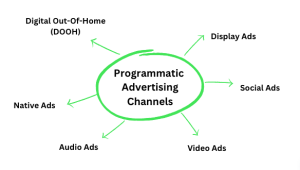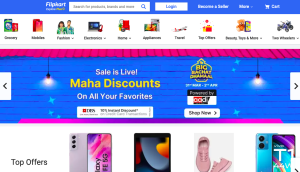Programmatic Advertising
Definition
Programmatic advertising is a data-driven approach to buying and selling digital advertising space in real-time using automated software platforms.
Description
It buys and sells digital advertising space using automated technology and real-time bidding. It uses algorithms and data to target specific audiences and serve ads on different channels such as websites, social media, and mobile apps.

The process involves using a demand-side platform (DSP) to manage ad campaigns and bidding on ad inventory in real time through supply-side platforms (SSPs) or ad exchanges. It is designed to be more efficient and effective than traditional advertising, allowing for precise targeting and optimisation based on data and performance metrics.
Importance of Programmatic Advertising
- Efficiency: It streamlines the ad buying process by automating the entire process, including ad placement, bidding, and optimization. This saves time and resources compared to traditional advertising methods.
- Targeting: It enables advertisers to reach specific audiences using data to target users based on their demographics, behaviour, and interests. This increases the chances of getting the right audience with the right message.
- Real-time optimization: It allows for real-time optimization of ad campaigns, meaning adjustments can be made based on performance data to improve the campaign’s effectiveness.
- Cost-effectiveness: It can be more cost-effective than traditional advertising, as advertisers can set specific budgets and only pay for impressions that reach their target audience.
- Access to data: Provides advertisers with access to data and insights that can be used to refine targeting, optimise ad campaigns, and improve overall performance.
Steps for Programmatic Advertising
- Define campaign objectives: The first step in programmatic advertising is to define the purposes, such as increasing brand awareness, driving traffic to a website, or generating leads.
- Identify target audience: The advertiser needs to identify the target audience based on the campaign objectives. This can be done using data such as demographics, behaviour, and interests.
- Choose ad format and creative: Next, the advertiser needs to choose the ad format and creative used in the campaign. This can include display ads, video ads, native ads, or other structures.
- Set campaign budget: The advertiser needs to set a budget for the campaign, which can be done either as a total spend or as a cost-per-impression (CPM).
- Choose a programmatic platform: The advertiser needs to choose a programmatic platform, such as a demand-side platform (DSP), that will be used to manage the ad campaign and bid on ad inventory.
- Set bidding strategy: The advertiser needs to set a bidding strategy, which determines how much they are willing to pay for each impression or click.
- Launch campaign: The campaign can be launched once all the previous steps have been completed. The programmatic platform will use algorithms and data to bid on ad inventory and serve ads to the target audience in real time.
- Monitor and optimise: After the campaign has launched, the advertiser needs to monitor its performance and make adjustments to optimise the campaign for better results.
Future aspect of Programmatic Advertising
The future of programmatic advertising is expected to see continued growth and innovation. Here are some of the critical aspects that are likely to shape the future:
- Increased automation: It will likely become even more automated, with artificial intelligence (AI) and machine learning (ML) used to optimise real-time ad campaigns.
- Advanced targeting: As data becomes more abundant, it is expected to see even more advanced targeting capabilities, including targeting individuals based on their offline behaviour and purchase history.
- Cross-device targeting: With the proliferation of devices and channels, it will likely focus on cross-device targeting, allowing advertisers to reach the same user across multiple devices.
- Privacy regulations: With increased concerns over data privacy, it is expected to evolve to comply with stricter regulations and user privacy preferences while still providing effective targeting.
- Integration with other technologies: It will likely become more integrated with other technologies, such as augmented reality (AR) and virtual reality (VR), providing new opportunities for immersive and engaging ad experiences.
- Increased use of programmatic TV: It is expected to make further inroads into the TV advertising market, providing more targeted and measurable ad campaigns.
Types of Programmatic Advertising
Advertisers can use several types of programmatic advertising to reach their target audience. Here are some of the most common types:
- Real-time bidding (RTB): This is the most common type of programmatic advertising, where ad inventory is bought and sold in real time through an auction process. Advertisers bid on impressions, and the highest bidder gets their ad served to the user.
- Programmatic direct: This is a type of advertising where advertisers buy ad inventory directly from publishers rather than through an auction process. This allows for more control over ad placement and targeting.
- Private marketplace (PMP): PMPs are invitation-only marketplaces where a select group of advertisers can buy ad inventory directly from publishers. This allows for more premium ad placements and better targeting.
- Automated guaranteed: In this type advertisers buy ad inventory directly from publishers, but the buying process is automated. This allows for more efficient ad buying while maintaining control over ad placement.
- Contextual targeting: It targets users based on the context of their viewing content. For example, an ad for a new car might be served to a user reading an article about cars.
- Behavioural targeting: This type of advertising targets users based on their past online behaviour, such as browsing history and search queries. This allows for more precise targeting based on user interests and preferences.
- Retargeting: Retargeting is targeting users who have previously interacted with a brand, such as visiting a website or adding a product to their cart. This allows for more personalised ad campaigns and can lead to higher conversion rates.
Example
Flipkart has used programmatic advertising to run targeted campaigns across various channels, including display, social media, and video ads. In addition, the company has leveraged data to identify the most effective ad formats and placements for each user, creating a personalised experience that drives engagement and conversion.

Flipkart has also used programmatic advertising to run retargeting campaigns, reaching users who have previously interacted with the brand and showing them relevant products or offers. The company has used dynamic creative optimization (DCO) to automatically adjust ad content based on user behaviour and preferences, delivering more relevant and personalised messages.
FAQ
What is programmatic advertising?
It is buying and selling digital advertising inventory through an automated system that uses data and technology to identify and reach target audiences more efficiently and effectively.
What are the benefits of programmatic advertising?
It allows advertisers to reach their target audience more precisely, with greater control over ad placement and targeting. It also offers improved efficiency and cost-effectiveness, as campaigns can be optimised in real-time based on performance data.
How does programmatic advertising work?
It works through a complex system of ad exchanges, demand-side platforms (DSPs), supply-side platforms (SSPs), and data management platforms (DMPs) that automate the buying and selling of digital ad inventory.
What types of programmatic advertising are there?
Several types of programmatic advertising include real-time bidding (RTB), programmatic direct, private marketplace (PMP), automated guaranteed, contextual targeting, behavioural targeting, and retargeting.
Is programmatic advertising only for display ads?
No, it can be used for various ad formats, including display, video, social media, and even audio ads.
How does programmatic advertising address privacy concerns?
It relies on data to target ads, but privacy regulations like GDPR and CCPA require advertisers to obtain user consent and provide transparency around data collection and usage.
How can I measure the success of programmatic advertising campaigns?
Success metrics for programmatic advertising campaigns may include impressions, click-through rates, conversions, and return on ad spend (ROAS). Data and analytics tools can help advertisers measure and optimise real-time campaign performance.
Is programmatic advertising suitable for small businesses?
Yes, programmatic advertising can benefit businesses of all sizes, offering greater targeting precision and efficiency than traditional advertising methods. Small businesses can benefit from programmatic advertising using self-serve platforms or working with a programmatic advertising agency.





We would love to have your opinion.